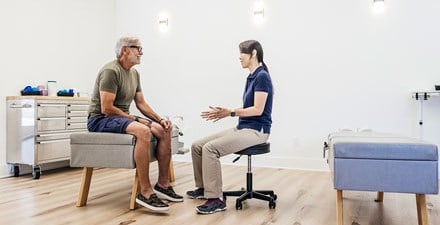
Working at a computer workstation all day can take a toll on the body — whether you work from home or in an office. Repetitive activities and lack of movement can contribute to aches, pains, and eventual injuries. So can prolonged sitting at a workstation that is not set up properly. Here are some tips from physical therapists to prevent and reduce aches and pains due to office work.
Move Regularly
Sitting at a desk while using the keyboard for hours on a daily basis can result in poor circulation to joints and muscles. It also can create an imbalance in strength and flexibility of certain muscles, and lead to muscle strain. These issues can be easily remedied by taking frequent short breaks, or "micro breaks," throughout your day.
- Get out of your chair several times a day and move around — even for 30 seconds.
- Roll your shoulders backwards.
- Turn your head side to side.
- Stretch out your forearms and your legs.
Set Up Your Workspace to Minimize Strain
Proper office ergonomics (setting up your office for the work you do) can help maximize your comfort and safety. Use the following guidelines for your workstation.
Your chair should have the following:
- Wheels (5 for better mobility).
- The ability to twist freely on its base.
- Adjustable height.
- Adjustable arm rests that will allow you to sit close to your desk.
- Lumbar support.
- Seat base that adjusts to a comfortable angle and allows you to sit up straight.
The position of the keyboard is critical:
- The keyboard should be at a height that allows you to have your forearms slightly below a horizontal line—or your elbows at slightly more than a 90-degree angle.
- You should be able to slide your knees under the keyboard tray or desk.
- Avoid reaching for the keyboard by extending your arms or raising your shoulders.
- Try to avoid having the keyboard on top of your desk. That is too high for almost everyone—unless you can raise your seat. The elbow angle is the best test of keyboard position.
The position of your computer monitor is important:
- The monitor should be directly in front of you.
- The top of the monitor should be at your eye level, and at a distance where you can see it clearly without squinting, or leaning forward or backward.
- If you need glasses for reading, you may need to have a special pair for use at your computer to avoid tipping your head backward to see through bifocals or other types of reading glasses.
How Can a Physical Therapist Help?
Many physical therapists are experts at modifying work stations to increase efficiency and prevent or relieve pain. Additionally, if you are experiencing pain that isn't relieved by making adjustments to your workstation, you should see a physical therapist who can help develop a treatment plan to relieve your pain and improve your mobility.
Physical therapists are movement experts who improve quality of life through hands-on care, patient education, and prescribed movement. You can contact a physical therapist directly for an evaluation. To locate a physical therapist in your area, visit Find a PT.


